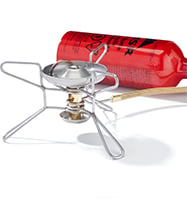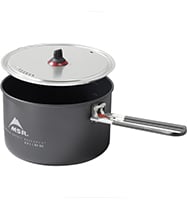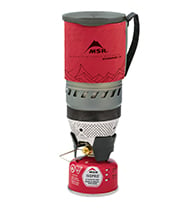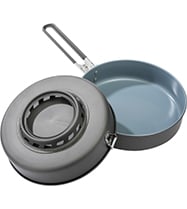Real Food for Mountaineering
When I began my journey of exploring the wilderness, initially I didn’t put much emphasis on meal prep, primarily focusing on the physical activity. During one college summer, I was working as a volunteer for the National Forest Service and my meals consisted mostly of Top Ramen® and Mountain House®. I had a personal stove, which I only used to boil water, and a variety box of Clif Bars® to fill in the gaps. I’m certainly not the first to survive on such a diet, but over the years I have learned to value quality nutrition and I now enjoy real cooking as part of my outdoor experience.
These days, I train quite frequently for skiing, climbing, etc., and my body craves more legitimate nutrients. I am also a creature of my particular comforts, so better food satisfies both those needs! I’m now a firm believer in enjoyable, quality sustenance in the mountains— it’s invaluable for both mental and physical performance. In this article, I will talk about where my real food recipe motivation is derived from, how I am actively using these skills while mountaineering, and include some of my favorite meals to enjoy!

How It Started: The Mindset
During a six-month beginner mountaineering course, a heavily emphasized concept was to not start your ‘goal weight’ diet plan during the course. The high energy output demanded by mountaineering and climbing requires fueling our bodies with performance in mind, which starts before and continues after the activity ends. Bonking on the mountain is probably one of the worst experiences; this is where you completely drain your energy and are almost too fatigued to finish the day. Throughout my course, I began to try foods and drinks during my conditioning hikes each month, and I discovered my go-to foods when on the approach. Personally, I always include something sweet, salty and fatty in my pack for the approach to not only satisfy my cravings but to give my body the necessary fuel to complete that day’s approach or hike.
My Go-To Goodies
My favorite snacks are a bag of Sour Patch Kids and/or peach rings (sweet) and mixed nuts, heavy on the walnuts and cashews (salty and fatty). I don’t eat the entire bag in most cases; I only feed my body the calories (energy) it craves. For drink, I usually pack one Nalgene of plain water and another Nalgene of TruWild™ Hydrate (an electrolyte and amino drink mix)—upon returning to the car, I have a protein drink ready, as well as more TruWild and regular water. It is very important to give yourself nutrients afterward, so your body can replenish and build.
If there’s one recommendation I can give, it’s that everyone should go out and discover what foods and drink your body wants during the hike. What are the foods that give you revitalizing energy when outside? Take some different options with you on a day hike and see what your body wants the most. I’ve been eating the same snacks for several years, and they still keep me going!
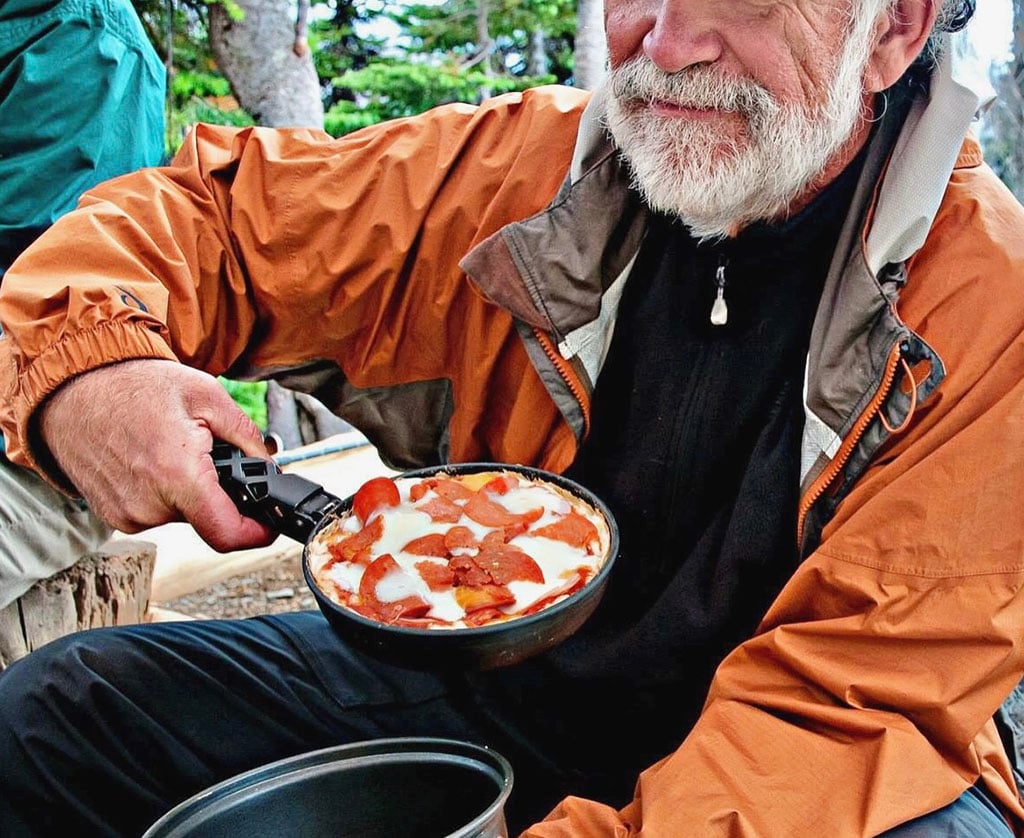
My Introduction to Real Mountaineering Food
While I’ve found that proper electrolytes and fuel for approach or day hikes are a bit more formulaic, meals for multiday adventures allow a much greater degree of flexibility and excitement! When I first began backpacking and mountaineering, I relied on good ol’ freeze-dried meals (like Mountain House). They are easy, fast, and replenish the salt that you sweat out as well as feed you the protein you need—all I needed to bring was my MSR Windburner Stove System to heat water. That basic approach to eating in the backcountry more or less ended when I went on my first expedition to Aconcagua, where I was really amazed at the kind of food we were eating above 14,000 feet. During some backpacking trips, I got the opportunity to enjoy cooked food from friends, but it was on Aconcagua I experienced real food in a mountaineering environment.
Serious Mountains, Serious Food!
On Aconcagua, I learned that actual food during my adventure not only feeds and replenishes my body but enhances my enjoyment and the entire experience. For breakfast, we would have bacon and eggs, pancakes, or quesadillas. Lunch would be snacks like fresh and dried fruit, granola bars, nuts, and cured meats and cheeses. Dinners were astounding; pasta and meat sauce, pizza, polenta, and stews or soups. Experiencing high-quality food at altitude accentuated my enjoyment and heightened my senses.
I already love being high up on a mountain, so adding fantastic meals to the equation made my expedition even more memorable. I came home from Argentina with a strong desire to share this with my friends and adventuring partners. For my journey, I love creating beautiful experiences and having great meals is part of that. While it’s a bit heavier in the pack, modern cooking equipment makes it an easy choice for me to carry a little extra weight for a lot more enjoyment.
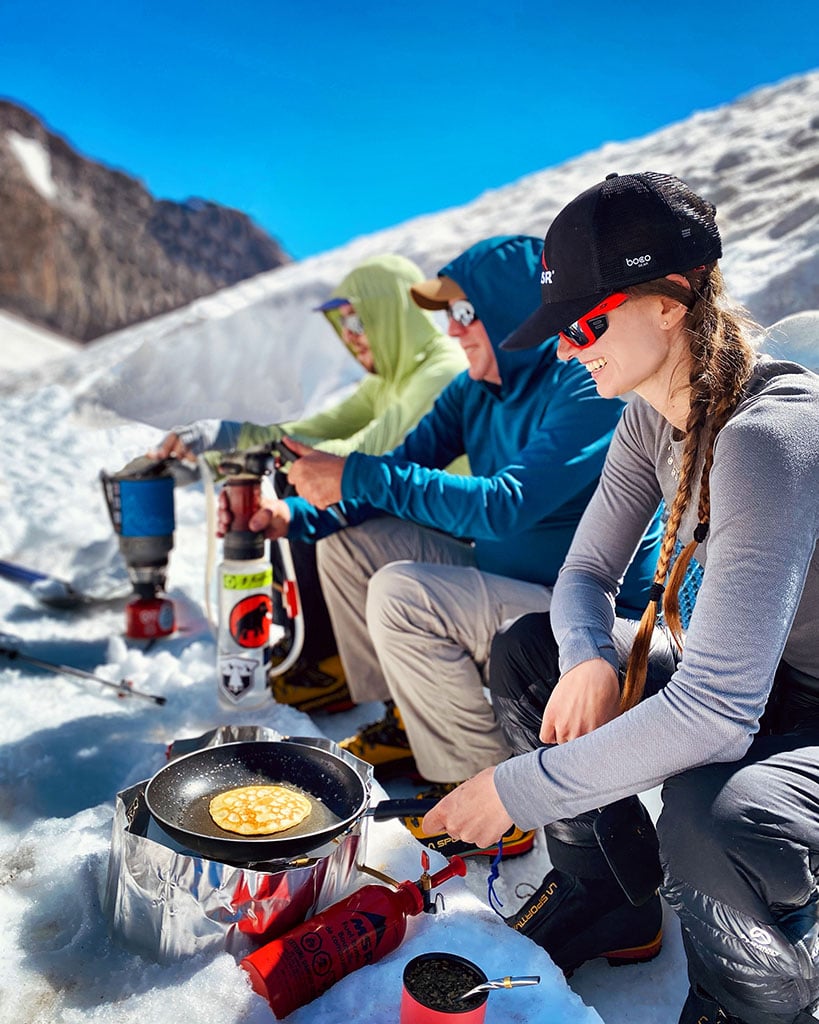
My Energizer Breakfast
Any time I plan an expedition, whether it’s three days or three weeks, tasty and nutritious meals are always factored in. I typically plan for breakfasts and dinners, with lunches consisting of snack items. A favorite breakfast of mine to prep is pancakes and eggs (with butter and syrup of course).
For the pancakes: I use a powder mix where the only added ingredient is water. I portion out the mix beforehand so I know roughly how many pancakes I will make, and store it in a large, thick ziplock bag (that later I can use for personal waste—pack out what you pack in). I store the butter (used on pancakes and to cook the eggs) in a smaller ziplock bag and the syrup in a reused 6-8 oz. plastic container like an old honey squeeze bottle. Don’t forget to duct tape the lid to prevent leaking!
For the eggs: I take a 12 oz. hard-sided water bottle and crack about ten eggs into it. This works very well for expeditions that take place on glaciers because you store the eggs (and any other items that need to be cooled) in a self-made snow cave/freezer. On drier expeditions, I will opt for powdered eggs.
To cook the pancakes, I love using MSR’s Ceramic Skillet with the additional cooking spatula, nicely browned and no sticking every time! Simultaneously, I cook the eggs in the mid-sized pot from the Alpine 4-Pot Set, generously using butter. Salt and pepper are added for taste, using MSR’s compact double-ended Alpine Salt And Pepper Container. I prepare these two dishes side by side on MSR’s highly versatile Whisperlite Stove Systems, another expedition necessity.
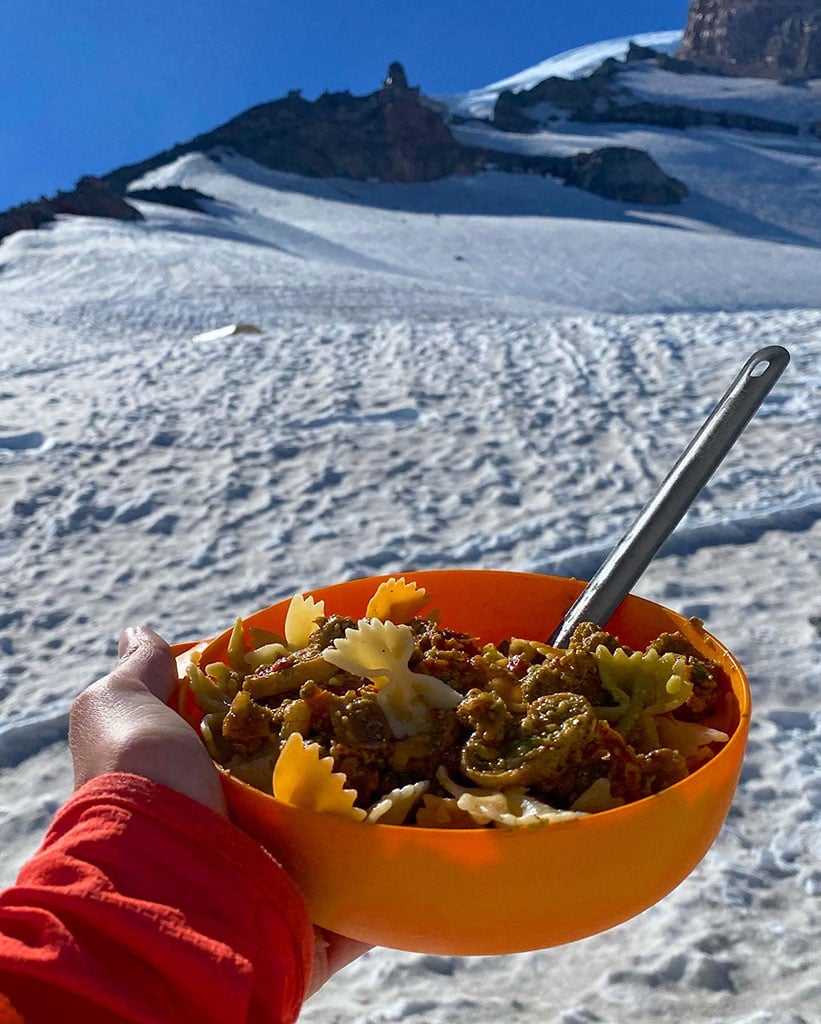
My Favorite Mountain Dinner
In my opinion, the Whisperlite systems are the golden standard for expedition cooking. After a day of trekking, I think about what sounds so satisfying—carbs and protein! Pasta is my favorite, so I love making a good plate of spaghetti with meat sauce.
For this meal: I carry the pasta uncooked still in packaging, the meat I precook at home (don’t forget to season well!) and place in another large, thick ziplock bag, and the pasta sauce I either use a just-add-water powder-based sauce or I carry an unopened plastic container of premade sauce.
I cook the pasta in MSR’s 2.5L Ceramic Pot, because it’s easy to strain the pasta afterward, and I prepare the meat sauce in the mid-sized Alpine Pot on low-medium heat. To serve either of the dishes, I love MSR’s versatile Two-Person Mess Kit and/or the lids of the Alpine Pot Set; they’re basically big plates! After a tiring approach day or the night before an ascent, this meal helps me recover and reenergize for the next day.

Enjoy the Experience!
Whether you’re backpacking, mountaineering, or doing some relaxed camping on the weekend, giving your body proper nutrients is a top priority. Throughout the last five years, I figured out what I need during my adventures to make a trip meaningful and enjoyable for me, and having wonderful meals has become a huge aspect of that. I love the morale and community of preparing bigger meals together; each team member has a task to complete that contributes to the final outcome: a delicious meal! Afterward, everyone feels happy and full and they are ready to sleep and fueled for the next day.
Ultimately, I encourage everyone to experiment—find out what makes you happy and fulfilled when you are outside. When you find and pursue what brings you passion, you will create a more rich and connected experience between yourself and nature, as well as those you share it with.
Related Posts:
- 9 Trail Snacks for Winter Hiking
- Best Camping Cookware & Stove Pairings
- 7 Best Ways to Make Coffee in the Backcountry
About the Author
Deanna Molenda is an avid mountaineer, climber, skier and route developer, with a number of first ascents already under her belt on routes she developed herself or assisted on. She travels around the United States for climbing, Maple Canyon being a favorite area she frequents. Before the pandemic she would travel to Argentina to tackle mountains above 5000m and climb; she hopes to get back on that track once travel restrictions are lifted. She continues to focus on growing herself with those near and dear to her, becoming the best version of herself, and enjoying every step of The Journey. Follow her on Instagram @deannamolenda.
Updated. Originally Published November 2, 2021.

